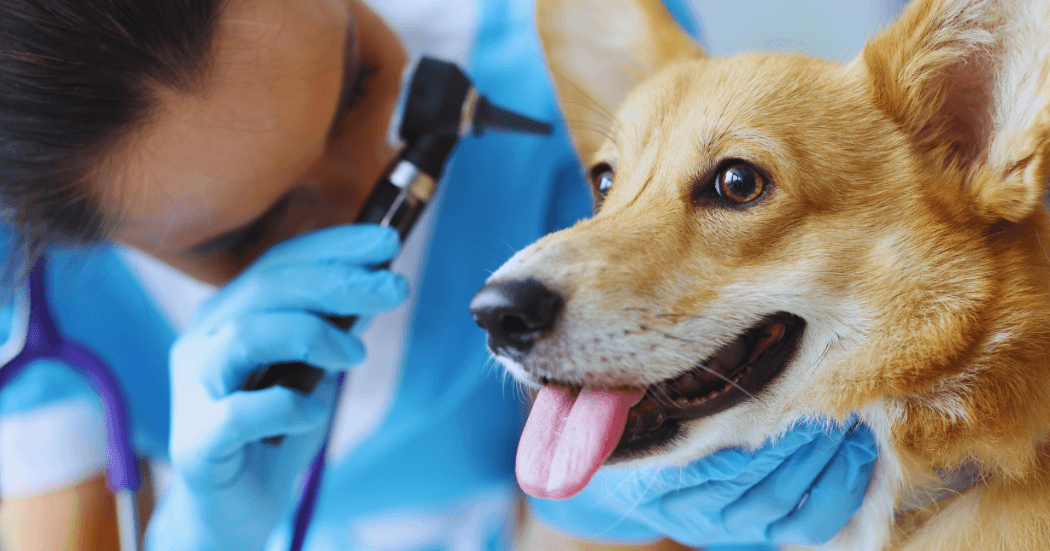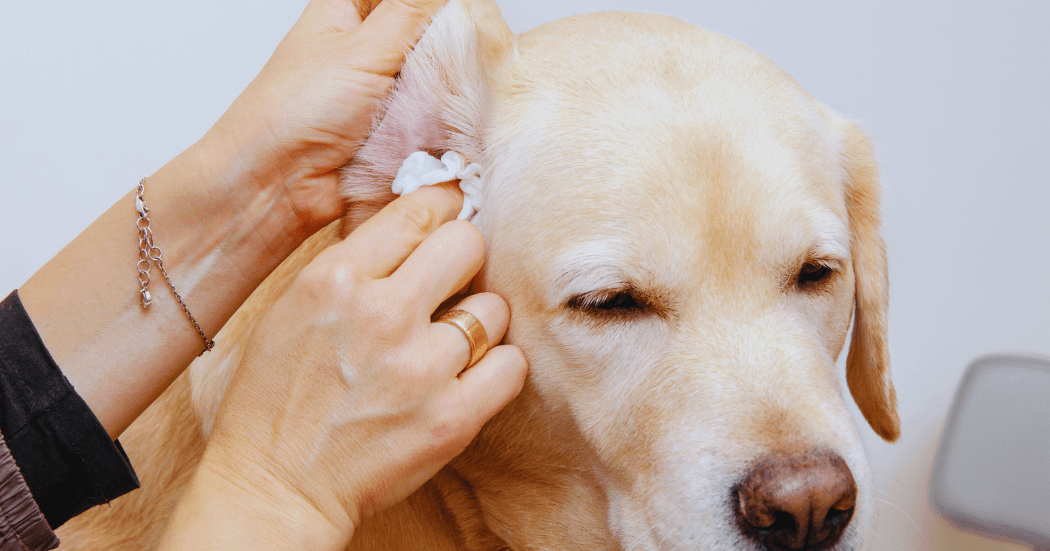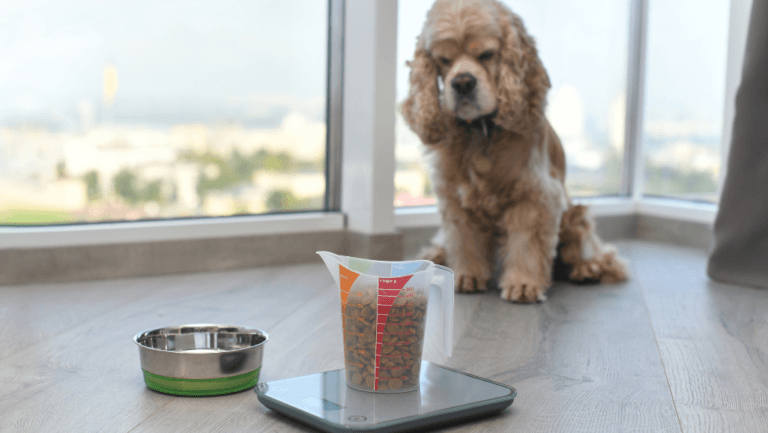Dog ear hematomas, or aural hematomas, are blood-filled masses in a dog’s ear. They make the ear feel and look thick. Dogs might get these from shaking or scratching their ears too much. This can happen when they have infections, allergies, or something in their ear.
Treating aural hematomas often involves dog ear hematoma surgery. After surgery, taking good care of your dog at home is important. It helps them heal well and prevents the problem from coming back.
Key Takeaways
- Aural hematomas are caused by irritation leading to excessive head shaking and scratching.
- Underlying conditions like infections, allergies, and bite wounds often contribute to hematomas.
- Surgical treatment is commonly used to remove the blood and stabilize the ear flap.
- Follow-up treatments involve removing drainage tubes or bandages within 3-14 days and sutures after two weeks.
- Untreated hematomas can lead to ear tissue damage and deformities.
- Consult a veterinarian promptly if you notice your dog frequently shaking their head.
What is a Dog Ear Hematoma?
A dog ear hematoma is when blood collects inside the ear flap. It gets big and swollen. This makes it painful for your pet. It usually happens because of broken blood vessels under the skin. Things like excessive head shaking or scratching can lead to this, especially with ear infections or allergies.
Signs of a dog ear hematoma are easy to see. The ear flap gets bigger and feels squishy. Your dog might scratch a lot or shake its head. This can get worse if your dog has a problem with bleeding or clotting. Quick action to treat this is very important for your pet’s health.
Vets need to handle ear hematomas in dogs. Surgery to drain the blood and fix the ear is common. The ear might need special care for up to two weeks after. Drainage tubes, bandages, and stitches help with this care.
There are other, less disruptive treatments. These include draining the blood and giving a steroid shot. Your dog might need this treatment more than once. After any treatment, it’s important to keep the ear clean and free from infection. An E-collar can stop your pet from bothering their ears and help them heal faster.
Finding and treating a dog ear hematoma early is key. This makes a big difference in your dog recovering quickly. With the right care, your dog will be back to normal soon.
Causes of Dog Ear Hematomas
It’s important to know the causes of dog ear hematomas. These are bloody swellings in the ear. They happen for many reasons. Knowing these reasons can help avoid them.
Infections and Allergies
Ear infections and allergies often cause hematomas. Infections make the ear swell and hurt. This makes dogs shake their head or scratch a lot. Likewise, allergies can make ears itchy. This can cause the blood vessels to break, leading to hematomas. Cleaning the ears often and using medicine can help.
Trauma and Injuries
Trauma and injuries also lead to hematomas. Rough play or bite wounds are common causes. These can hurt the ear’s skin or cartilage. Then, blood collects, forming a hematoma. It’s important to prevent such injuries to stop this from happening.
Blood-Clotting Disorders
Dogs with blood-clotting issues face a higher risk. They might bleed more after just a small injury. These dogs need special care to prevent hematomas. This care includes avoiding rough handling and any situations that could cause injury.
Signs and Symptoms of Dog Ear Hematomas
It’s vital to spot the signs of dog ear hematomas quickly. Ear hematomas are common in dogs. They make the ear flap look thicker and full of fluid, causing swelling. Sometimes, both ears can have this issue.
Lots of scratching, itching, and head shaking hint at a dog ear hematoma. This often happens in breeds with big ears. Their ears slap against their head, breaking blood vessels possibly from infections or allergies. If your dog seems off balance by tilting its head, it might be uncomfortable too.
Ignoring dog ear hematomas can lead to a really bad ear shape. A bad-shaped, inflamed ear is not looking or feeling good. So, looking for the right dog ear hematoma remedies fast is critical.
Diagnosing Dog Ear Hematomas
https://www.youtube.com/watch?v=Fq83KcaGgNA
It’s key to diagnose dog ear hematomas early to start the right treatment. Vets first visually check your dog’s ear for swelling. They then confirm if it’s a hematoma. This step is crucial as it shows if the ear flap is thick and filled with fluid, which are signs of a hematoma.
Visual Examination
A visual exam is the main way vets check for a dog ear hematoma. They look for swelling and redness in the ear flap. Since the causes can be from infections, allergies, or injuries, a close look is needed. This step checks if it’s really a hematoma and helps plan any other tests if necessary.
Underlying Conditions
It’s very important to find and treat the causes of a dog ear hematoma. To do this, vets may use many tests like checking for infections. They might also do blood and urine tests. These tests are used to find the root of the problem. From here, the best treatment plan is chosen.
By looking at both the hematoma and its causes, vets can create a specific treatment. Acting fast on infections, allergies, or other conditions improves the dog’s health long-term. It also helps stop the hematoma from happening again.
Treatment Options for Dog Ear Hematomas
To treat ear hematomas in dogs, it’s important to consider the immediate problem and the root causes. This approach ensures your pet stays healthy and happy for the long run.
Surgical Intervention
In severe or stubborn cases, surgery for dog ear hematomas is best. Surgeons cut the skin to drain the blood and then sew the skin back together. This prevents more blood from collecting. Dogs might need their ear supported with bandages to heal properly.
Conservative Management
For less severe hematomas, other methods can help. Warm compresses and draining with a needle can be used to avoid surgery. But, these methods need careful watching and sometimes extra treatment for a good outcome.
Medication
Medicines are vital for treating ear hematomas. Anti-inflammatory drugs help with pain and reduce swelling. Antibiotics are used to fight off infections that might make the hematoma worse. It’s also key to address any health issues that could cause more hematomas in the future.
| Treatment Method | Description | Pros | Cons |
|---|---|---|---|
| Surgical Intervention | Incisions, drainage, suturing | Most effective, immediate results | Requires anesthesia, postoperative care |
| Conservative Management | Warm compresses, needle aspiration | Non-invasive, avoids surgery | May require multiple treatments, less reliable |
| Medication | Anti-inflammatory drugs, antibiotics | Adds to other methods, treats underlying issues | May not be sufficient alone |
Care After Dog Ear Hematoma Surgery
After hematoma surgery, postoperative care is very important. It involves giving the dog the right medicines and looking after the cuts well. This avoids infections and helps the dog heal faster.
It’s crucial to stop the dog from scratching the surgery area. This can be done by using an E-collar. Self-damage is common but can be prevented this way.
It’s important to keep up with the vet to ensure the dog heals properly. Sutures are usually removed about three weeks after surgery. The vet will also check for any recurring problems.
Prevention is key in caring for dog ear hematomas. Addressing any infections or allergies is critical. It can help keep the dog’s ears healthy and avoid future hematomas.
| Aspect of Care | Description |
|---|---|
| Medication | Follow the prescribed medication regimen to control pain and prevent infection. |
| Incision Management | Keep the surgical site clean and dry; monitor for any signs of infection. |
| Prevention of Scratching | Use an E-collar to prevent the dog from irritating the surgical site. |
| Regular Veterinary Visits | Attend follow-up appointments for suture removal and to check for complications. |
Good care at home and preventive steps are essential for the dog’s recovery. Following these tips leads to better and faster healing.
Preventing Dog Ear Hematomas
To prevent dog ear hematomas, start by checking your dog’s ears often. Treat issues like infections and allergies right away. Doing this lowers the chance of these problems happening again.
- Frequent ear cleaning to remove debris that could cause irritation.
- Regular veterinary check-ups to identify and treat ear mites or infections.
- Monitoring for signs of allergies, which are primary dog ear hematoma causes.
- Using flea prevention methods to eliminate parasites that may induce aggressive scratching.
- Prompt treatment of ear infections, particularly yeast infections, as they are common triggers.
Many ear hematomas come from dogs shaking their heads too hard or scratching a lot. About 43% of cases are linked to ear infections causing this. It’s important to keep your dog calm and use products that ease ear discomfort. If your dog has big ears, you should watch them during play to prevent accidents.
Home Care for Dog Ear Hematomas
When a dog gets an ear hematoma, caring for them at home is key. You can help by applying warm compresses several times a day. This reduces the swelling. Don’t forget about any medicine the vet might give you. It’s crucial for easing pain and stopping inflammation.
To make sure the ear gets better, avoid letting your dog make it worse. Try to keep your pet quiet and not moving too much. This helps stop it from itching its ear or shaking its head. An Elizabethan collar also helps. It stops them from touching the inflamed area with their paws and claws.
Always keep an eye on your dog’s ear for any changes. Watch out for it getting red, swelling more, or smelling bad. These could mean it’s infected. If your dog seems tired or in pain, call your vet right away. This is so they can check on your pet and make sure everything’s okay.
On top of regular treatments, natural remedies can sometimes work well for ear hematomas. Things like witch hazel or yarrow oil might ease the symptoms. But remember, you should talk to your vet before using them. They’ll make sure it’s safe for your dog.
- Apply warm compresses to the affected ear.
- Administer prescribed medications diligently.
- Prevent the dog from scratching or shaking its head.
- Regularly check the ear for signs of infection or complications.
In the end, taking care of a dog ear hematoma at home is all about being careful and proactive. A mix of traditional and natural treatments can make a real difference. They can help your furry friend get better without further injuring themselves.
Conclusion
Dog ear hematomas need quick action to ease pain and prevent worse issues like cauliflower ear. They mostly happen because the dog shakes its head. You can spot aural hematomas with your eyes. It is key to treat the disease that’s causing them.
Treatments for dog ear hematomas range from simple, like draining the ear, to complex surgeries. These surgeries open the ear, drain the blood, and then close it back up. It’s best not to try home remedies because they may lead to problems. Always see a vet as soon as your dog starts shaking its head.
To prevent ear hematomas, take good care of your dog’s ears. Regular cleaning and checking can help. Also, try to avoid things that make the dog scratch a lot, like allergies and ear infections. By combining care and treatment, your dog’s health can greatly improve.




















